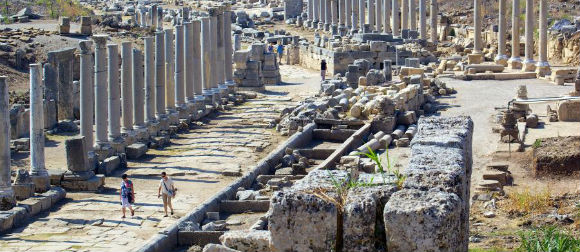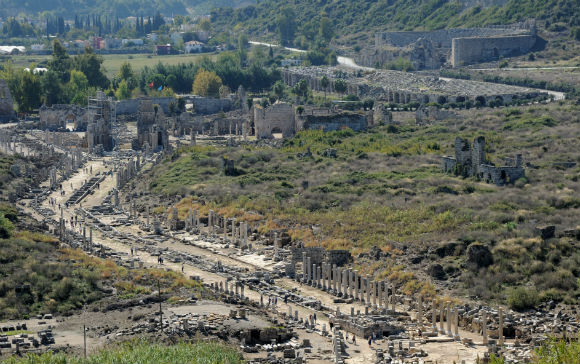The most impressive ruins of the Pamphylian coast are at Perge, at about 15 km east of Antalya. Perge was originally founded by the Hittites around 1500 BC. and was known as Parha. It was a successful trading centre near the Aksu (ancient Kestros or Cestrus) river when Alexander the Great arrived in 333 BC. He was welcomed in by the inhabitants and used Perge as base for his Anatolian campaigns. Alexander was followed by the Seleucids under whom the city prospered and Perge’s most celebrated inhabitant, the mathematician Apollonius from Perge lived and worked. Apollonius was a pupil of Archimedes and wrote a series of eight books on geometry. In 188 BC Perge became part of the Roman Empire during which the city flourished. Most of the surviving buildings date from this period.In 46 AD St. Paul started his journey in Perge (biblical Perga) and preached his first sermon here. Perge gradually declined during the Byzantine period, as the Aksu river silted, but remained inhabited until Selçuk times after which it became abandoned.
A visit to Perge starts by entering the archeological site through the Roman Gate, built during the reign of Septimius Severus (193-211 AD). Proceeding through the gate, to the right is the Agora or market place. This structure of 75 x 75 m dates back from the 2nd century AD. The center courtyard and shops were surrounded by a wide stoa, a covered walkway. The floor of the stoa and shops was made of colored mosaics. The agora was not only the centre of Perge’s trade, but was also a place for meetings as well as a forum for political, social, and philosophical discussions. The next building is the Hellenistic city gate that dates back to the 3rd century BC. This is certainly the most imposing building of the city and was cleverly designed to protect the city with its twin towers and its horseshoe-shaped courtyard at the back. It is thought that the towers had three floors and were crowned by a conical roof. In the year 121 AD, the horseshoe-shaped courtyard was rededesigned as a courtyard of honor. Behind the courtyard stood a triple arch. Around the arch there are about dozen inscriptions connected with Plancia Magna who lived in the 2nd century AD. She was the daughter of the governor, a priestess of Artemis Pergaia (Diana) and a benefactress to the city. Plancia Magna had the arch decorated with the statues of the emperors and their relatives.
After passing through the Hellenistic Gate and courtyard, one enters a broad, marble-paved double-colonnaded street measuring 300 meters in length that extends from the main gate to the acropolis. The street is 20 m wide and is divided in two by a 2 meter wide water channel running down the middle. At the end of the colonnaded street is the Nymphaeum, a triumphal fountain from where a stream flowed down into the water channel. The nymphaeum or nymphaion is an ornamental semicircular structure and dates from the reign of Emperor Hadrian (130-150 AD). A statue of a river god Kestros was located in the center of this huge fountain. Behind the nymphaeum is the acropolis with some remains of the Byzantine period. To the west of the nymphaeum are the remains of a palaestra dating from 50 AD and dedicated to the Emperor Cladius (41-54 AD).
Returning back to the entrance, there are the excavated Roman baths located southwest to the agora. Out of the site proper, is the horsehsoe-shaped stadium, the largest in Asia Minor, measuring 234 m by 34 m. The stadium had a seating capacity of 12,000 people supported by massive barrel-vaulted constructions. Just beyond the site entrance is also the theatre, which is of the Greco-Roman type and could seat 15,000 people. Unfortunately, it is for some time under reconstruction and unfortunately closed to visitors.
Perge,



We went on an organised trip made by our hotel rep. We really enjoyed it and was very happy that the tour guide took us early as it was 44 degrees and not a lot of shady areas.
Some parts of the site are still being excavated, it is very impressive to see.
A ancient roman settlement, still mainly intact. The town can be walked through and around.
For us the best part were the old baths, but the forum and the main street came close. There are archways, a fountainand a ground level aquaduct worth seeing. Outside the main town is a theatre, yhis is likely to be closed for safety reasons,…
A great example of a Roman town and you could imagine living in these times. There was no shade and little in the way of refreshments or resting places. For the truly dedicated
Every bit of the place is filled with history!!!
There are many reconstructed , interesting objects for sightseeing.
It's a must to visit in Turkey.
This is a very large impressive site.The guided tour was very interesting. Well worth a visit. We went on a nice sunny day and even though it was March it was hot so do take a drink with you.
We visited off season and had Perge almost to ourselves. This is relatively undeveloped, and you can explore the city as you like, discovering surprises and interesting things around every turn. The ruins of the baths are fantastic, and the main road with the water channel running down the center looks like the ancient model for the current Ataturk Caddesi…
Spend an hour or two looking at these ruins. I saw the tail of a snake disappearing between some of the stones, but I think it was of a non venomous species. Bring water in the summertime.
Fantastic what they achieved 1000 BC. Perge is close to Antalya, and we rented a car and combines Perge with Kudunlus waterfalls and Side
It is early afternoon and I`m gazing at some ruins in the historical city of Perge. Marble stones, stone columns, archeological finds of different sizes and importance are scattered around. Here before me some 2500 years ago, maybe even as early as 4000 years back as the signpost at the entrance indicates people have lived, worked, procreated, and died. I`m…
great place go with a guide or tag along with a group when there as there is not much info otherwise.